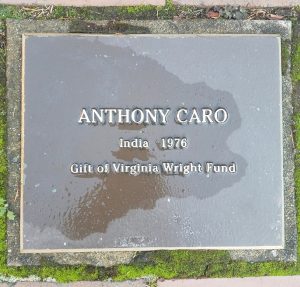Anthony Caro
Anthony Caro was initially surprised when he heard where India was being placed. Typically he likes to see his sculptures indoors, but Caro, after much thought, was content with the location of India. While he never wanted this sculpture, or any of his sculptures to have to compete with elements like buildings or trees, he felt as though the buildings formed an enclosure that was able to keep the piece the center of attention. In addition, he felt that they were far enough away that they didn’t interfere with the piece.
“It sounds as if the siting has been very sensitive.”
“If people are enjoying it, and feels it is the right scale, and if it has that sense of containment, say within the plaza formed by the buildings, then it sounds perfect.”
Looking back on the piece Caro revised some of his original thoughts about it. As for the name of the sculpture, India, according to Caro it does not represent the piece. While he had been to India before creating the sculpture, he feels that it does not reflect the country based off his travels there after the piece was created. He had originally named the sculpture India for reasons mainly unknown, it’s suspected that is was something to do with its enormous size. Caro related it to the size and shape of India on a map.
Caro’s sculptures have very vertical and horizontal features. For the piece, India, Caro had large sheets of metal leaned and layered against each other. This gives the structure vertical strength and depth. All angles to the piece are drastically different but from every angle it is still seen as large. The different layers, locations, and shapes of the steel that are welded together tells a different story at each angle you view India from.
Caro is known for his work with minimalism. His intent with this piece, and his other work, is to add only what he needs to the piece for the viewer to understand the meaning and its message. He wanted to paint or in this case, sculpt, a fairly clear view of what his intentions with the piece are.
An abstract artist, Caro, was born on March 8th of 1924 in New Malden, England. He is mainly known for his work with minimalist art. In 1942 he went to Christ’s College in Cambridge where he studied engineering. At that time he studied the works of another artist on breaks from the university in an effort to learn more about the creation of art, specifically sculpting. In the beginning of his career he dabbled-in mostly clay and plaster mediums starting at the age of 15, but later transitioned into creating abstract sculptures.
Caro specifically worked directly in scale that he required to represent the piece. So, the size in which his pieces are created have meaning and should be analyzed. When Caro spoke about another one of his pieces he said, “I didn’t want encrusted art-like objects. I wanted a sculpture that was in my world. I wanted something that moved me and meant something in terms of being there in a very immediate way…I wanted it stated, kind of there.” His words speak to the influence of minimalism that we see in his work.
After his time in Christ’s College he, for a short time, studied sculptures with Geoffrey Deeley. Caro then went and studied sculptures at Royal Academy Schools in London. He became an assistant to a celebrated british sculptor whose focus was within the post-war period. In regards to the piece “India” Caro traveled with his family to many places including India in 1971. This is when he became inspired to create this architectural piece. In addition, Caro traveled back to India about 13 years after creating the piece in 1989.
Works Cited
Clark-Langager, Sarah A. Sculpture in Place: a Campus as Site. Western Washington University, 2002
https://wp.wwu.edu/wwuart109/2017/05/17/anthony-caro-india-1976/
https://wp.wwu.edu/wwuart109/2017/05/15/india-anthony-caro-2/
Waldman, Diane. “Works .” Anthony Caro, Phaidon, 1982.
Clark-Langager, Sarah A. “Anthony Caro.” Sculpture in Place: a Campus as Site, Western Washington University, 2002.
Credits
Jade Johnson- Research, Admin, and Slideshow
Christopher Barnett- Research and Pictures
Hans Espling- Research


Leave a Reply